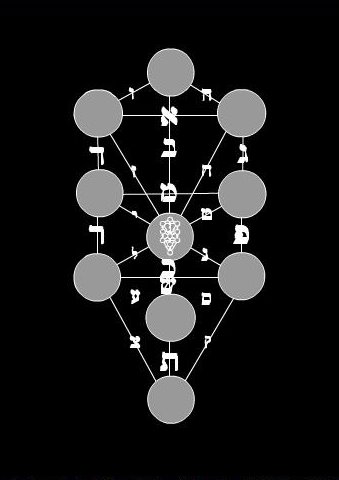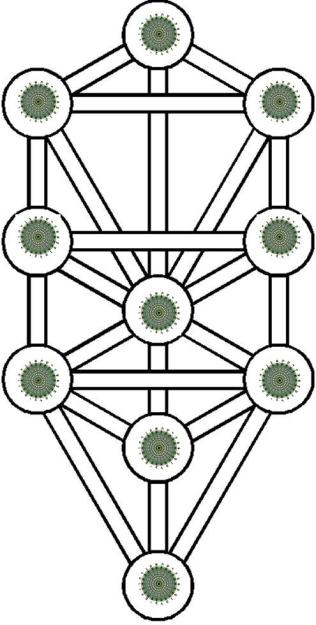You cannot conceive the many without the one.
Plato, Dialogues, Parmenides
No God – Within most texts explaining the mysteries of the QBL you will see oblique and opaque references to something called God as if we all know what this means. The etymological beginnings the word God or a God in its true meaning refers to spirit or a spirit – not necessarily a wise, omnipotent, all knowing all loving being. However the QBL provides us with many words to “know” this God more completely and avoid the often poorly understood common usage of the word: En Sof, the Limitless; El, the Mighty; and Adonai, Lord, amongst many many more. God in its general use is often seen to be an ineffability an unknowable force beyond human, beyond sense, beyond reason and as such, beyond discussion. We may come to the something called “God”, this “spirit” with many names through an understanding of its works, its creation – and in the QBL these works are undertaken through and with the Sefirot.
From reading the Sefer Yetzirah this essay recognizes the ten Sefirot as not only the tools and processes of creation but also as a map of the absolute direction of existence – spatial, temporal and observational. The ten Sefirot are the ten directions of the five polarities of the universe – up-down, east-west, north-south, beginning-end and good-evil. This essay will avoid spurious references to God and instead use the rich literature of QBL to describe spirit and its mode of operation within manifestation, the Sefirot – we will use and provide explanations of the meaning for God names, alternative names used in core texts, the Sefirot as universal directions of existence, and letters as the pathways we take within it to provide the most precise meanings we can.
The Sefirot are described as depths and the letters as infinite so although our essay will attempt to provide a comprehensive but concise account of the metaphysics behind the system, it must not be taken as fact or as all that is known and the student who would follow his own path should use texts like these only as guidelines for his own journey into the mysteries.
Crown/Keter – A crown sits on the head of a king as a sign of his majesty and influence; to crown a work is to perfect it. A king without a crown is bereft of recognition in his kingdom; a crown alone is ring of rare metal and precious stones enclosing nothing. In the Early Kabbalah, the Sefirot were all called Keter – that is, per the Sefer Yetzirah, ten crowns of nothingness.
Existence/Ahyeh – Keter is known by the God-name of Ahyeh or existence. We have in Keter then the simplest concept of being or doing – existing. Taken in its fullest context we have the idea of Keter as all existence, and therefore the universe – creation itself as the crown of “the King of creation” (see Tif – Malakh).
Nothingness/Ayin – When we look into the universe we see immense reaches of nothingness, untold billions of leagues of empty space, distances so vast that even light itself takes epoch-smashing amounts of time to cross – so much so that when we look into space we look back into time at the light from the stars that has journeyed millions of years to reach and show us what once was. Since space and time are so intimately linked it is not only space that is mostly empty, but time itself as well.
Absence/He’der – Within this boundless ocean of emptiness we do observe little islands of form and matter but further observations, penetrating into the nature of matter itself, reveal tiny particles of opposing and neutralizing charge orbiting each other, from their perspective, at yet more vast distances of empty space. Indeed, were one atom a football pitch, the nucleus would be a ball on the kick off spot, and the opposing electrons would be peas circling around the lines of the edge of the pitch itself! Nearly all of the field is empty! Our islands of matter within the empty cosmos have been shown to be hollow and empty themselves, spheres of absence punctuated by the tiniest flickering sparks that oppose and neutralize.
Obliteration/Hefsed – Atoms are composed of protons, neutrons and electrons. The charges on protons and electrons are opposed and cancel out within the stable atom or molecule, but the mass of a single atom concentrated within the nucleus, the tiny football in the gulf of atomic absence, is composed of titanic energies which when released can destroy whole cities and worlds. When one is heading with love towards the highest of the worlds the Kabbalists counsel one to withdraw in fear and trembling for fear of being obliterated; the core of the Earth is a super dense sphere of molten uranium which no man-made vehicle could penetrate without being ripped asunder.
Darkness/Hoshekh – In Lurianic Kabbalah, Keter is said to be the light of En Sof (a limitless expanse) concentrated to a single point within a hollow sphere. Concentrating atoms into an ever increasing density leads to a monstrous magnification of the forces of gravitation, and ultimately to the phenomena known as a black hole. Built in the imploding core of a supermassive star which gives light by crushing matter, black holes are so powerful they bend both space and time and even swallow light. At the very core of our galaxy, the primum mobile itself, there may well be clusters of giant black holes, their rotation and their swirling gravitational pull dragging the stars into their familiar spiral arrangement. Black holes themselves look white because we can only see them by the light they suck in – light itself travels along grooves in space-time caused by the gravitational maelstrom caused by the interaction of all celestial bodies.
Unity/Achad – Keter is one, the unit, the basis of mathematical reasoning which is the crown of the intellect. Keter is the everything that did not come from something, and will always be what it is forever; it fails to know even nothing as its father for as we have seen, the stuff of it is nothingness, and it operates within nothingness – the nothingness is the one. This everything certainly contains some things but these things by virtue of there being from the one thing that is everything are united in that one thing. It is impossible for us to take our existence outside of the existence we are within and look at it, but if we could we would surely see only the tiniest spark and this is all. From within this existence that is our existence, we simply see it streaming off in all directions; spatial, temporal and observational.
Thought/Machashavah – The oneness of Keter that serves maths, serves the mind as well for 1 is not so different from I. Keter is said, by Isaac the Blind, to be “thought” – it is the idea of one, i.e. Me, that the self depends on – as Adam Kadmon, the essential self awareness which is the true identity of man and the fifth and highest world, the tip of the Yod; as Arikh Anpin, the partzuf of Keter, the “Long Suffering One” who experiences all the countless identities within the one thing, and suffers as we suffer.
Alef, Yod and Qoph – These letters by virtue of their numerical oneness (1, 10, 100) take from and lend to the idea of Keter. Alef, the silent inbreath before speech, the airiness that blows leaves, the ox that symbolizes work about to be done. Yod, the closed hand, a sign of concealment, or as a fist, force about to be unleashed – with the fingers closed the five dimensions are clasped tight. Qoph the back of the head, that which we cannot see, and that part we rest upon when we close our eyes to the darkness of the self that cannot be known, when we close our eyes on the great concealment.
Keter is the sefira that symbolizes both everything and nothing. It is everything in that it is existence, the cosmic crown of universal perfection, the unity that binds all form to the singular master and the building block of both mathematics and identity. But it is also nothingness, the emptiness that gives the form of things their structure and power, the darkness of our acknowledged ignorance that separates the tiny sparks of matter and knowledge that are scattered within the limitless cosmos.







